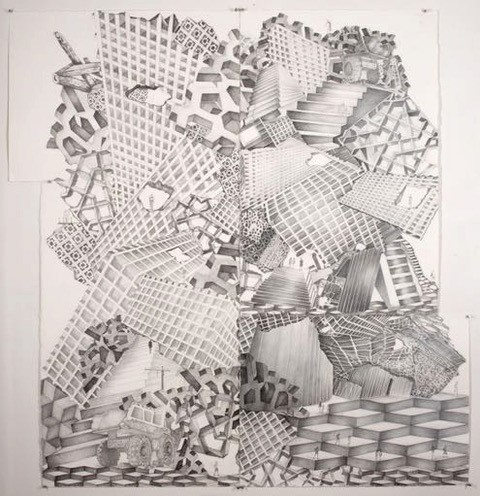Summary |
A studio-based project seeks to challenge the picturesque conventions governing the depiction of ruins in the past |
|---|---|
Start Date |
Nov 28, 2018 12:00 pm |
End Date |
Dec 3, 2018 5:00 pm |
Venue |
Plimsoll Gallery |
Unstable Territories: Imaging and Imagining the Contemporary Ruin.

Image credit: An Artist’s Impression of MONA as a Ruin 2, silver coloured pencil and graphite pencil on paper,160 x 142 cm, 2016
Exhibition dates: Sat 28 Nov – Wed 3 Dec, 2018
Gallery Hours: Wed - Sun 12pm - 5pm (during exhibitions)
Closed Tuesdays and Public holidays
Abstract:
This studio-based project seeks to challenge the picturesque conventions governing the depiction of ruins in the past and to find a new set of visual strategies more appropriate to the contemporary experience of ruins in urban settings.
Pivotal to the project has been the case study of a unique, local urban ruin site, the Myer site, (2007-2014). It has been used as an indicative example of the distinctive characteristics of a contemporary unscenic ruin in order to establish a structural framework for the development of visual strategies that take account of the physical and spatial limitations of a specific site.
These strategies pose challenges and establish visual alternatives to the picturesque aesthetic. This research has sought to demonstrate its inadequacy in dealing with both the imaging and imagining of the experiential, compromised condition of real time ruins.
The depiction of this site has wider implications for the field of ruin scholarship and the research considers this challenge through the posing of two questions.
How is picturesque space changed when its panoramic scope is compromised by the enclosed and impeded physical and visual reality of contemporary urban ruin sites?
How do the visual strategies of destabilisation and fragmentation generate new visual outcomes when imaging and imagining contemporary ruins?
The research examines the Western artistic tradition of the representation of ruins, identifying two category of ruins: 1) the scenic ruin, which encompasses the Romantic tradition of the picturesque, ruin gazing and ruin lust, and 2) the unscenic ruin, which includes three sub -types- the anxious, the catastrophic and the prosaic ruin.
The scenic ruin tradition has been analysed through artworks by Giovanni Battista Piranesi, J.W. M. Turner, John Constable, Caspar David Friedrich and its contemporary iteration, ruin porn while the discussion of unscenic ruin is outlined through an analysis of artwork by Anselm Kiefer, Joel Meyerowitz and Ed Ruscha’s reworking of The Course of Empire series by Thomas D. Cole. It is in relation to the latter category of ruin, in particular, the prosaic ruin that this project is situated.
Theoretically, the project has been supported by the concepts of ‘unscenic nature’ as outlined by Yuriko Saito and “terrain vague” formulated by Ignasi de Sola Morales which best describe the conditional state of unscenic sites as well as highlighting aesthetic alternatives to picturesque spatial formula.
The visual strategies that have been employed include patterns of visual disturbance, which impede clear perception and fragmentation achieved through collage as imagined through the state of collapse. These strategies have resulted in two distinct bodies of artwork across two media; colour wood cut prints and monochrome graphite, charcoal and pencil drawings.
Identifying that the current field of ruin representation is largely silent on the picturing of ruins in urban settings, this research establishes two significant and innovative alternatives that are more appropriate to the experience of the contemporary ruin.